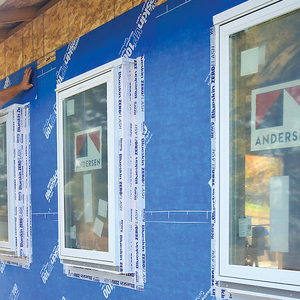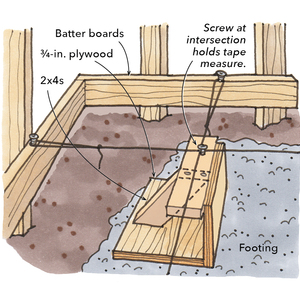To insulate or not insulate old foundations
Hi, I’m a renovator in Toronto, Ontario and I repeatedly come across the issue of whether or not to insulate non-waterproofed basements. There are many opinions floating around that say to insulate a wet (or potentially wet) basement is subjecting it to damage from freeze/thaw cycles as it will no longer be warmed by the interior. Is this based in science or just fear? I have searched extensively for an answer but can find none. Anybody have some info?



















Replies
Try this site, considered perhaps the most knowledgeable....
in the science behind the methods of building.
http://www.buildingscienceconsulting.com/index.html
and of course:
http://www.greenbuildingadvisor.com/advisors/joe-lstiburek-gba-advisor
Certainly basements around here are insulated.
Freeze damage to foundations doesn't come from the foundation itself freezing, but from the ground nearby freezing and expanding inward. Forgoing insulation will do little to prevent the ground from freezing.
I believe that current building science is promoting the idea of bringing a basement or crawlspace into the conditioned space of the building. To accomplish this one would install insulation onto the walls of the underground space and quite possibly on the floor, dirt or otherwise, as well. This is in contrast to insulating the floor above, a practice that excludes the basement or crawl from being heated. One needs to also install plastic sheeting over the damp earth floor.
I've found that a lot of people in my area are not in tune with this practice. It goes against the long standing idea of letting the foundation area breath to avoid mildew and mold.
The forum at JLC has some lively discussions on this matter. You'll need to do a search there. Fortunately their search function works very well.
As to the matter of frost damage: if your foundation is situated in and on frost susceptible soils, you may not want to insulate the foundation. A heated foundation that "leaks" heat will create a thaw bulb around the building and thus stabilize the susceptible soils. I think the situation is sort of "two wrongs to make a right."
Sap
" A heated foundation that "leaks" heat will create a thaw bulb "
Here in NW Oh. with our clay soils I have seen recently (last winter) a couple of examples of foundations that were pushed in during the freezing months. The cause seems to have been a dry summer-the clay shrinks back leaving a void between the soils and foundation walls which filled with water during a thaw/rain spell mid winter. It buckled both poured and reinforced block walls as the winter continued, the temps dropped and the frost was driven further into the ground.
The thing both foundations had in common-no stone backfill and poor drainage away from the house (roof drains not taken away from foundation). Also, neither had been finished to the inside-so the presense of a "warm" wall didn't do much to help. The situation and force from the outside was just too much. It's going to take the whole "science" to address this problem. I think you'll agree, no quick easy fix on foundation problems.
I never meant to imply that there was a quick solution to all foundation problems. But allowing a basement to heat the surrounding soil ought to help minimize any frost damage. At least that's always been my understanding, but I've zero practical experience with clay soils.
Even though it will be going further off course for the OP... a slight correction is in order. Frost isn't "driven" into the ground. Heat flows out.
More pertinent to the matter at hand: I'm trying to make sense of all the new building science discussion that is being discussed these days. Sealing a basement/crawlspace certainly goes against my old understandings. For that matter so does the degree of air sealing we do to the entire building envelope. We used to be told to fluff up the insulation.... now we want it dense. Sigh. What's an old dog to do?
Keep reading, I guess.
keep reading........
and hope for the best.
Being talented today is taking a whole lot of ambition.
And then of course, you can't just take anything for granted either. I'm sure you've heard some pretty lame things touted as the gospel. Figurning out which way is right is no easy matter. It used to be thought we knew what we were doing just because we'd been doing it for 30 yrs. No more................
Best of luck.
insulating foundations
This is our experience from 40 years
winter construction in calgary: never backfill with claymaterials from a claysoil excavation to save backfill material. Backfill material was pea-gravel or riversand, weeping tile around perimeter a MUST, any final grading to have slope away from foundation. If basement was finished, interior framewall 1" away from concrete basementwall, 6mil poly on inside concrete wall up to gradelevel only between frame wall and concrete wall, R12 batt insulation and 6 mill vaporbarrier to underside of floorsheathing above. No mould, no moisturebuild up. Never any problem
winterconstruction in BC westcoast: No backfill with claymaterial, same as in Calgary. Exterior basementwalls insulated, covered with drainmat, perimeter drainage to stormsewer, interior basementwalls rigid insulation.
On slab-on-grade construction: exterior walls insulated with rigid insulation, at footinglevel rigid insulation extended 4', perimeter drainage, slab underside 12" compacted gravel, 6mil poly, 3" rigid insulation, steelmesh, 4" 28MPA concrete
Never any problem
Older crawlspaces,: exterior walls inside insulated (mostly) with R20, 6mil vaporbarrier, one open heatduct in wintertime, occasionally run summerswitch on furnace to ventilate crawlspace
No problems